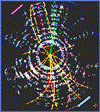Department of Physics and Astronomy: Publications and Other Research

Kenneth Bloom Publications
Document Type
Article
Date of this Version
2008
Abstract
The Compact Muon Solenoid (CMS) detector is described. The detector operates at the Large Hadron Collider (LHC) at CERN. It was conceived to study proton-proton (and leadlead) collisions at a centre-of-mass energy of 14 TeV (5.5 TeV nucleon-nucleon) and at luminosities up to 1034 cm-2s-1 (1027 cm-2s-1). At the core of the CMS detector sits a high-magnetic field and large-bore superconducting solenoid surrounding an all-silicon pixel and strip tracker, a lead-tungstate scintillating-crystals electromagnetic calorimeter, and a brass-scintillator sampling hadron calorimeter. The iron yoke of the flux-return is instrumented with four stations of muon detectors covering most of the 4π solid angle. Forward sampling calorimeters extend the pseudorapidity coverage to high values (|η| ≤ 5) assuring very good hermeticity. The overall dimensions of the CMS detector are a length of 21.6 m, a diameter of 14.6 m and a total weight of 12500 t.


Comments
Published in Journal of Instrumentation 3 (2008) S08004; doi: 10.1088/1748-0221/3/08/S08004 (U.S. Government document) See page XX for University of Nebraska-Lincoln authors.